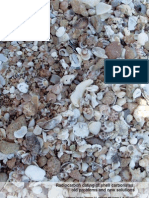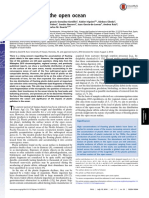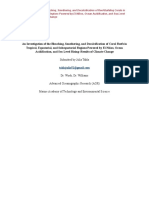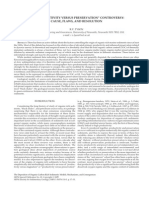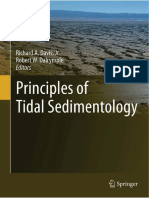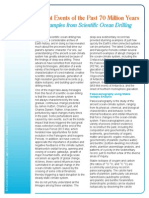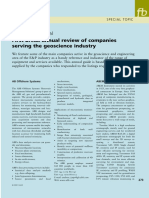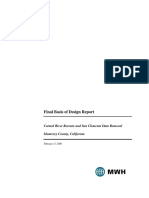2020 - Fox - Quantifying The Effect of Anthropogenic Climate Change On Calcifying Plankton
2020 - Fox - Quantifying The Effect of Anthropogenic Climate Change On Calcifying Plankton
Uploaded by
pizhonghzOriginal Title
Copyright
Available Formats
Share this document
Did you find this document useful?
Is this content inappropriate?
Report this DocumentCopyright:
Available Formats
2020 - Fox - Quantifying The Effect of Anthropogenic Climate Change On Calcifying Plankton
2020 - Fox - Quantifying The Effect of Anthropogenic Climate Change On Calcifying Plankton
Uploaded by
pizhonghzCopyright:
Available Formats
www.nature.
com/scientificreports
OPEN Quantifying the Effect of
Anthropogenic Climate Change
on Calcifying Plankton
1,2* 1 1 1
Lyndsey Fox , Stephen Stukins , Thomas Hill & C. Giles Miller
Widely regarded as an imminent threat to our oceans, ocean acidification has been documented in
all oceanic basins. Projected changes in seawater chemistry will have catastrophic biotic effects due
to ocean acidification hindering biogenic carbonate production, which will in turn lead to substantial
changes in marine ecosystems. However, previous attempts to quantify the effect of acidification on
planktonic calcifying organisms has relied on laboratory based studies with substantial methodological
limitations. This has been overcome by comparing historic plankton tows from the seminal HMS
Challenger Expedition (1872–1876) with the recent Tara Oceans expedition material (2009–2016). Nano
CT-scans of selected equatorial Pacific Ocean planktonic foraminifera, have revealed that all modern
specimens had up to 76% thinner shells than their historic counterparts. The “Challenger Revisited”
project highlights the potential of historic ocean collections as a tool to investigate ocean acidification
since the early Industrial Revolution. Further analyses of such biotic archives will enable researchers to
quantify the effects of anthropogenic climate change across the globe.
The HMS Challenger expedition from 1872 to 1876 can claim to be the foundation of modern oceanographic
studies. This historic voyage was the first to specifically gather data on a broad range of ocean features, including
ocean temperatures, seawater chemistry, currents, marine life, and the geology of the seafloor1,2. In 2022 scientists
will celebrate 150 years since the HMS Challenger first left port to begin this ground-breaking oceanographic
expedition. During this time scientific and technological methods have advanced substantially, but the wealth
of knowledge associated with the modern ocean systems is in stark contrast to the fundamental lack of baseline
ocean data from the Industrial Revolution onwards3.
The wealth of historical collections housed at museums and similar institutions across the world can often
be overlooked for cutting edge climate research. At the Natural History Museum, London, the Ocean Bottom
Deposits (OBD) collection4, which includes vast amounts of material from the HMS Challenger expedition, pro-
vides an almost unique source of microfauna to compare pre-industrial oceans to those of today. In this study:
“The Challenger Revisited Project”, the collection provides a unique opportunity to study the effects of one of
the most urgent questions of our time with regards to anthropogenic environmental change: ocean acidification
(OA)5.
It is now widely accepted that OA is an imminent threat to our oceans5,6, and although we have a good under-
standing of the related changes in ocean chemistry, the widespread biological impacts of OA remain unclear.
Since the beginning of the industrial revolution (1760 onwards), CO2 emissions from the burning of fossil fuels
and changes in land use have led to an increase in atmospheric CO2 levels concentrations of 280 ppm to, presently,
over 400 ppm7, with a dramatic change in magnitude and rate of the human imprint from 1950 onwards known
as “The Great Acceleration”8. Without significant mitigation, CO2 values are expected to rise to between 550 and
1000 ppm, depending on emission scenarios, by the end of this century7.
Oceanic carbonate ion concentrations decrease as a consequence of increased atmospheric CO2 levels9, which,
in turn, has a negative effect on the capacity for calcifying organisms (such as molluscs, crustaceans, corals, and
foraminifera) to form their essential skeletal or shell material out of calcium carbonate9–13. Worryingly, recent
laboratory experiments and marine chemical models suggest that eventually calcification rates could slow to the
point where they are outpaced by dissolution, and during the 21st century, corals and other calcifying organisms
may suffer a great decline. Planktonic foraminifera are one such group that are highly important contributors to
1
The Natural History Museum, Cromwell Road, London, SW7 5BD, UK. 2Department of Geography, Geology,
and Environment, Kingston University London, Penrhyn Road, Kingston upon Thames, Surrey, KT1 2EE, UK.
*email: [email protected]
Scientific Reports | (2020) 10:1620 | https://doi.org/10.1038/s41598-020-58501-w 1
www.nature.com/scientificreports/ www.nature.com/scientificreports
Figure 1. (A) Locations of all Challenger stations visited between 1872–1876; (B) Location map of Challenger
station 272 and Tara stations 127 and 128 used in this study, equatorial Pacific Ocean. Map was generated using
the marmap package in R42.
carbon cycling in the ocean14. They are not only responsible for a quarter or more of global carbonate produc-
tion15, but also an integral component of the marine food chain16. However, to date there is little information
available with regards the impact of OA on calcification rates of planktonic foraminifera. While lab-based studies
are invaluable in assessing short-term controls on calcification in certain species, they do not allow for adaptation
in planktonic foraminifera, which have to date, never reproduced in a laboratory environment16.
Attempts to evaluate the impact of OA on calcification in the oceans have been hindered by an inability to
directly compare the calcification capability of today’s plankton species with equivalent specimens from exclu-
sively pre-and early-industrial times17. Field-based studies have tried to compare the calcification ability of a
modern plankton species today with their pre-industrial counterparts by using seafloor sediments to represent
‘pre-industrial’ times. However, one centimeter depth of deep sea sediment may represent 100’s of years of Earth’s
history18, therefore this method inevitably incorporates a mix of specimens from a large window of geological
time, leading to potential circularity when comparing data from these sediments to modern sediment traps or
plankton tows.
Multiple plankton tows collected by the HMS Challenger crew from across the world’s ocean basins between
1872–18761 provides a resource that resolves issues highlighted in both lab-based and field-based studies; the tow
material contains the planktonic foraminifera, of a known age, that were alive in the open ocean at the time of
sampling. Thus, the HMS Challenger collection provides exceptional baseline data for 19th–21st century ocean
acidification evaluation. Here we present the results of a focused study from the central Pacific Ocean (Fig. 1),
a region identified as being vulnerable to ocean warming, ocean acidification, and ocean deoxygenation with
increasing atmospheric CO2 levels19,20. The results of this study highlight the utility of museum collections for
studies of anthropogenic climate change, and demonstrates an urgent need for more empirical data.
Results
Here we test the utility of these collections for modern climate change studies by comparing specimens of plank-
tonic foraminifera collected in tow nets from HMS Challenger Station 272 (1875) (Fig. 1) with Tara expedition
(2011)21 stations 127 and 128, in the eastern Pacific Ocean; a region that is recognized as being particularly
vulnerable to deoxygenation and surface warming in the wake of anthropogenic climate change20. Both Tara
and HMS Challenger stations were sampled during September thus removing seasonal bias from our study. Tow
samples that had been stored in ethanol immediately after collecting were analysed under light microscope and
picked for planktonic foraminifera, with selected specimens imaged using a scanning electron microscope (SEM)
to test for any visible signs of dissolution (Fig. 2). Of these, 24 specimens (12 historical and 12 modern) were
then selected for imaging using X-ray computed tomography (CT). Nano-CT scanning provides an innovative
technique for assessing shell properties, and offers the advantage of yielding many different parameters (wall
Scientific Reports | (2020) 10:1620 | https://doi.org/10.1038/s41598-020-58501-w 2
www.nature.com/scientificreports/ www.nature.com/scientificreports
Figure 2. (a–h) Nano-CT scan of planktonic foraminifera specimens with colourmap of test thickness, warm
colours indicating areas of relatively thicker shell; (a,b) Globigerinoides ruber (Tara), (c) Globigerina bulloides (Tara),
(d) Neogloboquadrina dutertrei (Tara), (e) G. ruber (Challenger), (f) Trilobatus trilobus (Challenger), (g) N. acostaensis
(Challenger), (h) N. dutertrei (Challenger); (i–p) SEM images of selected planktonic foraminifera specimens;
(i) T. trilobus (Tara), (j) G. ruber (Tara), (k) G. ruber (Challenger), (l) G. bulloides (Challenger), (m,n) G. ruber test
cracked to reveal wall texture (Tara), (o,p) G. ruber test cracked to reveal wall texture (Challenger).
thickness, chamber volumes etc.), per single scan. It also allows a comprehensive investigation into the entire
shell, not just small sections, to display changes in shell thickness during the life cycle of the protozoan, whilst also
taking into account areas of differing thickness due to shell structure morphology22 (Fig. 3).
Inspection of the outer surface of the shells using SEM revealed all selected specimens to be in good condi-
tion with no evidence of dissolution or recrystallisation23,24 (Fig. 2). A subsample of test calcite from Globigerina
bulloides was further analysed using X-ray diffraction, which revealed no differences in CaCO3 peaks between the
HMS Challenger and Tara specimens (Fig. 4).
The results of the Nano CT-scanning revealed that, without exception, all modern foraminifera specimens
had measurably thinner shells than their historical counterparts (Figs. 3 and 4A–D). In addition, due to the
extremely thin walls of several specimens from Tara data set, the initial voxel size of 2.4 μm was insufficient to
Scientific Reports | (2020) 10:1620 | https://doi.org/10.1038/s41598-020-58501-w 3
www.nature.com/scientificreports/ www.nature.com/scientificreports
Figure 3. Nano-CT representative reconstructions and measurements for Neogloboquadrina dutertrei from
Tara (a–c), and Challenger (d–f); 2a and (d) Colour map illustrating shell thickness, warm colours representing
areas of relatively thicker test wall; 2b and (e) cross section through rendered foraminifera test; 2c and (f) slice
through foraminifera test.
properly render the data. A total of 4 specimens were scanned at sub-micron resolution (~0.7 um); 2 from HMS
Challenger (1772–1876) samples and 2 from Tara Oceans (2009–2013) plankton tows. We analysed two species:
Globigerinoides ruber and Neogloboquadrina dutertrei, and collected between 8 and 27 replicate measurements
of test thickness per chamber, from the final 3 chambers of the test (Supplementary Table 1). A Shapiro Wilks
normality test was performed on the chamber thickness data and an independent t-test assuming equal variance
was subsequently selected to test whether the observed differences in shell thickness between preindustrial and
modern specimens are significant.
Analysis of the higher resolution scans (~0.7 μm) revealed that specimens of N. dutertrei from both the
historic and modern assemblages show the similar patterns of shell thickness, in that the walls of test cham-
bers become progressively thinner towards the final chamber (Fig. 4A,B). The specimens analysed in the first
scan (Fig. 4A) revealed a mean shell thickness of 28.60 ± 1.43 μm in the HMS Challenger specimen compared
to 14.94 ± 0.73 μm recorded in the Tara specimen. The specimens of N. dutertrei analysed in the second scan
(Fig. 4B) record similar results with a mean shell thickness of 24.99 ± 0.85 μm in the HMS Challenger specimen,
and 5.96 ± 0.23 μm in the Tara, equating to a reduction in shell thickness of up to 76%.
Quantitative measurements of the test wall in specimens of G. ruber revealed mean test thickness of
16.34 ± 0.39 μm (Fig. 4C) and 15.5 5 ± 0.51 μm (Fig. 4D) for the HMS Challenger specimens and 11.74 ± 0.53
μm and 13.96 ± 0.45 μm in the Tara specimens. This equates to an overall reduction in shell thickness of up to
30%, however statistical analysis of the individual chambers in G. ruber revealed that the observed differences in
test thickness of chamber 3, between the preindustrial and the modern were not significant. Over all this species
records similar but less marked differences in the mean shell thickness compared to N. dutertrei. This may be due
to differences in calcification between species.
Discussion
Initial findings of the Challenger Revisited project have revealed a reduction in shell thickness of up to 76% in
selected species of planktonic foraminifera over the last c. 140 years, which corresponds to a period of profound
change in our oceans. Ocean acidification is not the only stressor faced by the world’s oceans in the coming dec-
ades and over the time period studied here. Rising temperatures and deoxygenation are also likely to have a sub-
stantial impact on marine ecosystems, and eastern boundary upwelling systems are likely to be strongly affected
by all three stressors20. A recent study by Roemmich et al. (2012) comparing Challenger sea surface temperature
Scientific Reports | (2020) 10:1620 | https://doi.org/10.1038/s41598-020-58501-w 4
www.nature.com/scientificreports/ www.nature.com/scientificreports
Figure 4. (A,B) Shell thickness measurements of N. dutertrei; (C,D) Shell thickness measurements of G. ruber.
Pink circles represent HMS Challenger (1875) specimens, blue circles represent Tara (2011) specimens, squares
represent the mean thickness for each chamber; (E) X-ray diffraction data for specimens of G. bulloides. Black
line represents HMS Challenger data, red line represents Tara data.
measurements (1872–1876) to a more recent data set from the Argo Programme (2004–2010) revealed substan-
tial warming of the modern upper ocean, with a warming signal that is global in its extent. We propose OA as
the lead cause for the observed reduction in calcification of planktonic foraminifera as our results closely mirror
results from laboratory studies and field observations from the Arabian sea17. However, It could be argued that
rising temperatures, deoxygenation and OA are intrinsically linked and therefore these stressors should not be
separated. More work is required to further explore the application of this method by increasing sample sizes
Scientific Reports | (2020) 10:1620 | https://doi.org/10.1038/s41598-020-58501-w 5
www.nature.com/scientificreports/ www.nature.com/scientificreports
and undertaking comparative studies in other ocean basins. Though the HMS Challenger samples only pro-
vide a snapshot of early industrial ocean conditions, the method has potential for global reconstructions. The
“Challenger Revisited project” will be expanded beyond the Pacific Ocean, and the methodology can be applied
to other historical expedition collections such as the Terra Nova [1911–1915] and Discovery [1920–1930s] when
comparatory contemporary expedition materials are available.
Whilst all specimens analysed showed some reduction in shell thickness, the degree to which different species
responded varied greatly. Specimens of N. dutertrei, a non-spinose, thermocline-dwelling planktic foraminif-
era that possesses intracellular chrysophyte alga25,26 revealed up to 76% reduction in shell thickness between
the preindustrial and the modern, whereas G. ruber specimens display a far smaller decrease in shell thickness
(~20%). G. ruber is a spinose multichambered species known to occupy the mixed layer of the ocean and hosts
photosynthesising algal symbionts (dinoflagellates) which can alter the chemistry of the sea water immediately
surrounding the shell and therefore enhance calcification27,28. Numerous studies have demonstrated that a variety
of calcifying organisms respond negatively to decreasing ocean pH, such as coccolithophores, pteropods and
corals22,29,30. However, certain photosynthesising organisms have been shown to benefit from higher availability
of dissolved CO231.
To further investigate all drivers for these differences in shell thickness, the effect of depth habitat on calcifica-
tion ability is worth further study, as is how photosymbiont hosting foraminifera and also the types of symbionts
may be more resilient to decreasing pH. Studies of the fossil record have shown that foraminifera, when under
extreme stress, will shed their symbionts in the process of bleaching32.
In addition, the application of directed geochemical analyses have the potential to disentangle the multiple
factors that could be driving the reductions in shell thicknesses shown here. Boron isotope analysis on compa-
rable historic and modern planktonic foraminifera shells can provide accurate reconstructions of pH conditions
at the time of shell development33–35, which in turn links the reduction of ocean carbonate ions as the driver for
reduced shell calcification. There is therefore the potential to gain new insights into the rate of change taking
place in the oceans, contributing greatly to our understanding of the sensitivity of global climate systems to CO2
forcing. Such insights are crucial for predicting the future climate and health of the oceans.
Sample Information
Our preindustrial specimens were collected at HMS Challenger station 272 in the Southwest Pacific Ocean on the
8th of September 1875 (3°48′0″S, 152°56′0″W), using a tow net “resembling long night-caps, of fine muslin or cal-
ico, and 10 to 16 inches in diameter at the mouth”1. In the HMS Challenger volumes the nets are reported as being
towed at various depths, “even as far as 800 fathoms”36, however the ship’s station book does not record the depth
at which the nets were towed at individual stations. Sea surface and bottom temperatures, the sounding, “nature
of the sea floor” and species recovered are recorded. The expedition logs are publicly available at the library of the
Natural History Museum, London.
A small sub-sample of the HMS Challenger material (50 g) was taken from the stores and gently washed using
deionised water, the residues were dried in an oven at 40o C. Specimens were selected from the 250–500 um size
fraction for further analysis.
The Tara Oceans specimens came from station 127 (6°37′12.00″S, 152°34′4.80″W) and station 128
(0°28′8.04″S, 153°18′19.44″W) in the Pacific ocean and were collected between the 31st of August and 5th of
September 2011 from the Deep Chlorophyll Maximum (DCM) layer (100 m)21. We analysed 10 ml aliquots from
the 180–2000 um size fraction, samples were stored in a freezer in ethanol. Detailed accounts of the collection
methodology can be found in Pesant et al. 2015.
Species identifications follow the existing understanding of modern foraminiferal taxonomy37–39. The pri-
mary classification is based on the chamber arrangement, wall structure and principally spinose or non-spinose
ornamentation40,41.
Methods
Nano-CT scanning. Nano-CT scanning was carried out with a Zeiss Versa 520. Samples were analysed in
pairs using a customised pine wood mount. Sample mount, X-ray source and detector geometry were kept con-
stant throughout the first set of scans (Fig. 2). A scan resolution voxel (a 3D unit of space which varies in dimen-
sions between CT reconstructions depending on scanning parameters) size of 2.4 µm3 was typically achieved
using this set up in order to maximize the number of specimens that could be analysed in a single scan. During
the second run of scans (Fig. 3) focusing on just 4 specimens (2 historic and 2 modern), X-ray source and detector
were positioned to maximize resolution and a voxel size of <0.8 µm3 was achieved. Between 700–1000 individual
X-ray absorption profiles of each mount were taken and combined to build a 3D rendering of the image using
Avizo 9.2 software which was also used for image analysis.
The differential X-ray absorption of organic matter, pine wood, and calcium carbonate translates into different
greyscale intensities in the reconstructed 3D image; therefore, it was possible to filter out pine wood and organic
material from the analysed data for volume, wall thickness etc. Object volume, average thickness and surface area
were determined using standard Volume Graphics analysis. In addition, dimension measurements were taken on
3D renderings of shells. For N. dutertrei and G. ruber, three dimensional measurements were taken, the width (at
the widest point), the width at half shell length and length (Fig. 2a). Object volume, average thickness and surface
area were determined using standard Volume Graphics analysis. For direct comparisons between shell thickness,
weight and density of the old and new samples, a size filter was applied to the dataset and only individuals of the
same length were used.
X-ray diffraction. Specimens of Globigerina bulloides were picked for X-ray diffraction analysis as they were
relatively abundant in both Tara and Challenger samples, between 5 to 10 shells were soaked in ethanol and
Scientific Reports | (2020) 10:1620 | https://doi.org/10.1038/s41598-020-58501-w 6
www.nature.com/scientificreports/ www.nature.com/scientificreports
gently ground in an agate mortar and deposited on a circular sapphire substrate. The XRD data were collected
using an ENRAF-Nonius 590 diffractometer with a Tintel curved position sensitive detector (PSD). The angular
linearity of the PSD was calibrated with silicone powder and silver behenate. This apparatus collects data from
2–120 °2θ continuously throughout the experiment. Cobalt Ka radiation was selected from the primary beam by a
Germanium 111 crystal monochromator with the x-ray tube operating at 40 kV and 30 mA. Horizontal and verti-
cal slits restricted the beam to a height of 0.14 mm and width of 5 mm. Data were collected with samples spinning
continuously in the plane of the sample surface and with the sample surface at an angle of 4° to the incident beam.
Detailed statistics. Neogloboquadrina dutertrei. Scan 1. In chamber 1 (the final chamber in the whorl), the
preindustrial (Challenger) specimens recorded a mean shell thickness of 20.60 ± 0.56 μm, and a mean thickness
of 8.93 ± 0.44 μm was recorded in the modern (Tara) specimen. A two sample t-test assuming equal variance
was carried out. The t-statistic calculated was 16.593 and the two- tailed probability was 0.000. Therefore we can
conclude there is a significant difference in shell thickness between the Challenger and Tara specimens.
In chamber 2, the preindustrial (Challenger) specimens recorded a mean shell thickness of 28.02 ± 1.2 μm,
and a mean thickness of 18.12 ± 0.89 μm was recorded in the modern (Tara) specimen. A two sample t-test
assuming equal variance was carried out. The t-statistic calculated was 6.71 and the two- tailed probability was
0.000. Therefore we can conclude there is a significant difference in shell thickness between the Challenger and
Tara specimens.
In chamber 3, the preindustrial (Challenger) specimens recorded a mean shell thickness of 37.98 ± 1.30 μm,
and a mean thickness of 16.19 ± 0.90 μm was recorded in the modern (Tara) specimen. A Mann Whitney U
test showed that there was a significant difference (U = 170, p = 0.000) between the preindustrial and modern
specimens.
Scan 2. In chamber 1 (the final chamber in the whorl), the preindustrial (Challenger) specimens recorded a
mean shell thickness of 20.16 ± 0.65 μm, and a mean thickness of 4.33 ± 0.17 μm was recorded in the modern
(Tara) specimen. A two sample t-test assuming unequal variance was carried out. The t-statistic calculated was
24.142 and the two- tailed probability was 0.000. Therefore we can conclude there is a significant difference in
shell thickness between the Challenger and Tara specimens.
In chamber 2, the preindustrial (Challenger) specimens recorded a mean shell thickness of 22.55 ± 0.59 μm,
and a mean thickness of 5.44 ± 0.27 μm was recorded in the modern (Tara) specimen. A two sample t-test assum-
ing unequal variance was carried out. The t-statistic calculated was 26.521 and the two- tailed probability was
0.000. Therefore we can conclude there is a significant difference in shell thickness between the Challenger and
Tara specimens.
In chamber 3, the preindustrial (Challenger) specimens recorded a mean shell thickness of 32.87 ± 0.90 μm,
and a mean thickness of 7.89 ± 0.33 μm was recorded in the modern (Tara) specimen. A Mann Whitney U
test showed that there was a significant difference (U = 432, p = 0.000) between the preindustrial and modern
specimens.
Globigerinoides ruber. Scan 1 In chamber 1 (the final chamber in the whorl), the preindustrial (Challenger) spec-
imens recorded a mean shell thickness of 16.60 ± 0.59 μm, and a mean thickness of 10.38 ± 0.59 μm was recorded
in the modern (Tara) specimen. A two sample t-test assuming equal variance was carried out. The t-statistic
calculated was -7.459 and the two- tailed probability was 0.000. Therefore we can conclude there is a significant
difference in shell thickness between the Challenger and Tara specimens.
In chamber 2, the preindustrial (Challenger) specimens recorded a mean shell thickness of 15.74 ± 0.74 μm,
and a mean thickness of 12.74 ± 1.12 μm was recorded in the modern (Tara) specimen A Mann Whitney U test
showed that there was a not a significant difference (U = 95.5, p = 0.000) between the preindustrial and modern
specimens.
In chamber 3, the preindustrial (Challenger) specimens recorded a mean shell thickness of 17.40 ± 0.78 μm,
and a mean thickness of 14.52 ± 0.45 μm was recorded in the modern (Tara) specimen. However insufficient
replicate measurements were collected (<10) to perform statistical analysis of the data.
Scan 2. In chamber 1, the preindustrial (Challenger) specimens recorded a mean shell thickness of 12.71 ± 0.25
μm, and a mean thickness of 10.01 ± 0.47 μm was recorded in the modern (Tara) specimen. A Mann Whitney U
test showed that there was a significant difference (U = 58.5, p = 0.000) between the preindustrial and modern
specimens.
In chamber 2, the preindustrial (Challenger) specimens recorded a mean shell thickness of 18.77 ± 0.64 μm,
and a mean thickness of 15.06 ± 0.48 μm was recorded in the modern (Tara) specimen. A two sample t-test
assuming equal variance was carried out. The t-statistic calculated was 4.749 and the two- tailed probability was
0.000. Therefore we can conclude there is a significant difference in shell thickness between the Challenger and
Tara specimens.
Statistical analysis of the measurements taken on chamber 3 suggest that any observed difference in shell
thickness is not significant.
Received: 30 July 2019; Accepted: 15 January 2020;
Published: xx xx xxxx
References
1. Wyville Thompson, C. The Voyage of the “Challenger”. The Atlantic. 2 volumes (1878).
2. Roemmich, D., Gould, W. J. & Gilson, J. 135 years of global ocean warming between the Challenger expedition and the Argo
Programme. Nature Climate Change 2, 425–428 (2012).
3. Jonkers, L., Hillebrand, H. & Kucera, M. Global change drives modern plankton communities away from the pre-industrial state.
Nature, 1, https://doi.org/10.1038/s41586-019-1230- (2019).
Scientific Reports | (2020) 10:1620 | https://doi.org/10.1038/s41598-020-58501-w 7
www.nature.com/scientificreports/ www.nature.com/scientificreports
4. Rillo, M. C. et al. The unknown planktonic foraminiferal pioneer Henry A. Buckley and his collection at The Natural History
Museum, London. Journal of Micropalaeontology 36(2), 191–194 (2016).
5. Orr, J. C. et al. Anthropogenic ocean acidification over the twenty-first century and its impact on calcifying organisms. Nature 437,
681–686 (2005).
6. Secretariat of the Convention on Biological Diversity. An Updated Synthesis of the Impacts of Ocean Acidification on Marine
Biodiversity. Montreal, Technical Series 75, 1–99 (2014).
7. IPCC. Climate Change 2013: The Physical Science Basis. Contribution of Working Group 1 to the fifth assessment report of the
Intergovernmental Panel on Climate Change. [Stocker, T. F., Qin, D., Platter, G. K., Tignor, M., Allen, S. K., Boschung, J., Nauels, A.,
Xin, Y., Bex, V. & Midgeley, P. M (eds.)], Cambridge University Press, Cambridge, United Kingdom and New York, NY, USA, 1535
(2013).
8. Steffan, W., Broadgate, W., Deutsch, L., Gaffrey, O. & Ludwig, C. The trajectory of the Anthropocene: The great acceleration. The
Anthropocene Review 2, 81–89 (2015).
9. Barker, S. & Ridgwell, A. Ocean Acidification. Nature Education Knowledge 3(10), 2 (2012).
10. Moy, A. D., Howard, W. R., Bray, D. G. & Trull, T. W. Reduced calcification in modern Southern Ocean planktonic foraminifera.
Nature Geoscience 2, 276–280 (2009).
11. Osborne, E. B. et al. Calcification of the planktonic foraminifera Globigerina bulloides and carbonate ion concentration: Results from
the Santa Barbara Basin. Paleoceanography 31(8), 1083–1102 (2016).
12. Lischka, S. et al. Impact of ocean acidification and elevated temperatures on early juveniles of the polar shelled pteropod Limacina
helicina: mortality, shell degradation, and shell growth. Biogeosciences 8, 919–932 (2011).
13. Wittman, A. C. & Pörtner, H. O. Sensitivities of extant animal taxa to ocean acidification. Nature Climate Change 3, 995–1001
(2013).
14. Langer, M. R. Assessing the Contribution of Foraminiferan Protists to Global Ocean Carbonate Production 1. Journal of Eukaryotic
Microbiology 55(3), 163–169 (2008).
15. Henehan, M. J. et al. Size dependent response of foraminiferal calcification to sea water carbonate chemistry. Biogeosciences 14,
3287–3308 (2017).
16. Hemleben, C. et al. Modern Planktonic Foraminifera. Springer. 215 (1989).
17. de Moel, H. et al. Planktic foraminiferal shell thinning in the Arabian Sea due to anthropogenic ocean acidification? Biogeosciences
6, 1917–1925 (2009).
18. Lyle, M. Deep-Sea Sediments. In: Harff J., Meschede M., Petersen S., Thiede J. (eds) Encyclopedia of Marine Geosciences. Springer,
Dordrecht, (2015).
19. Turley, C. et al. The societal challenge of ocean acidification. Marine Pollution Bulletin 60(6), 787–792 (2010).
20. Gruber, N. Warming up, turning sour, losing breath: ocean biogeochemistry under global change. Philosophical Transactions of the
Royal Society A: Mathematical, Physical and Engineering Sciences 369(1943), 1980–1996 (2011).
21. Pesant, S. et al. Open science resources for the discovery and analysis of Tara Oceans data. Scientific data 2, 150023 (2015).
22. Howes, E. L., Eagle, R. A., Gattuso, J. P. & Bijma, J. Comparison of Mediterranean pteropod shell biometrics and ultrastructure from
historical (1910 and 1921) and present day (2012) samples provides baseline for monitoring effects of global change. PloS ONE
12(1), e0167891 (2017).
23. Johnstone, H. J., Lee, W. & Schulz, M. Effect of preservation state of planktonic foraminifera tests on the decrease in Mg/Ca due to
reductive cleaning and on sample loss during cleaning. Chemical Geology 420, 23–36 (2016).
24. Sexton, P. F., Wilson, P. A. & Pearson, P. N. Microstructural and geochemical perspectives on planktic foraminiferal preservation:
“Glassy” versus “Frosty”. Geochemistry, Geophysics, Geosystems 7(12), Q12P19 (2006).
25. Gastrich, M. D. Ultrastructure of a new intracellular symbiotic alga found within planktonic foraminifera. J. Phycol. 23, 623–632
(1987).
26. Fehrenbacher, J. et al. Link between light-triggered Mg-banding and chamber formation in the planktic foraminifera
Neogloboquadrina dutertrei. Nat. Commun. 8, 15441.
27. Lombard, F., Erez, J., Michel, E. & Labeyrie, L. Temperature effect on respiration and photosynthesis of the symbiont‐bearing
planktonic foraminifera Globigerinoides ruber, Orbulina universa, and Globigerinella siphonifera, Limnology and Oceanography, 54
(2009).
28. Aze, T. et al. A phylogeny of Cenozoic macroperforate planktonic foraminifera from fossil data. Biological Reviews 86, 900–927
(2011).
29. Gonzalez-Delgado, S. & Hernández, J. C. The importance of natural acidified systems in the study of ocean acidification: what have
we learned? In Advances in marine biology 80, 57–99 (2018).
30. Davis, C. V. et al. Ocean acidification compromises a planktic calcifier with implications for global carbon cycling. Scientific reports
7(1), 2225 (2017).
31. Hutchins, D. A., Mulholland, M. R. & Fu, F. Nutrient cycles and marine microbes in a CO2-enriched ocean. Oceanography 22(4),
128–145 (2009).
32. Edgar, K. M. et al. Symbiont ‘bleaching’ in planktic foraminifera during the Middle Eocene Climatic Optimum. Geology 41(1),
15–18 (2013).
33. Foster, G. L. Seawater pH, pCO 2 and [CO 2− 3] variations in the Caribbean Sea over the last 130 kyr: a boron isotope and B/Ca
study of planktic foraminifera. Earth and Planetary Science Letters 271(1), 254–266 (2008).
34. Hönisch, B. & Hemming, N. G. Ground‐truthing the boron isotope‐paleo‐pH proxy in planktonic foraminifera shells: Partial
dissolution and shell size effects. Paleoceanography 19(4), PA4010 (2004).
35. Foster, G. L. & Rae, J. W. Reconstructing ocean pH with boron isotopes in foraminifera. Annual Review of Earth and Planetary
Sciences 44, 207–237 (2016).
36. Hjort, J., Murray, S. J., Appellöf, A., Gran, H. H. & Helland-Hansen, D. B. The Depths of the Ocean: A general Account of the Modern
Science of Oceanography Based Largely on the Scientific Researches of the Norwegian Steamer Michael Sars in the North Atlantic
(1912).
37. Hsiang, A. Y. et al. Endless Forams: >34,000 Modern Planktonic Foraminiferal Images for Taxonomic Training and Automated
Species Recognition Using Convolutional Neural Networks. Paleoceanography and Paleoclimatology 34, 1157–1177 (2019).
38. Brummer, G. J. A. & Kucera, M. SCOR/ICBP 138 taxonomy and key to species of modern planktonic foraminfera v2.1. Chart
distributed at TMS FNG meeting Texel, The Netherlands, June 2014: 1 (2019).
39. Brummer, G.J.A. & Kucera, M. Taxonomy of extant planktonic foraminifera, SCOR/IGBP WG138; August 2015. In: Sprero, H. and
Kucera, M. (Editors), SCOR/IGBP Working Group 138: Planktonic Foraminifera and Ocean Changes. Final Workshop & Short Course
on Culturing Planktonic Foraminifera. California, 8 (2015).
40. Fleisher, R. L. Cenozoic planktonic foraminifera and biostratigraphy, Arabian Sea Deep Sea Drilling Project, Leg 23A, in Whitmarsh,
R. B., and others (eds.), Initial reports of the Deep Sea Drilling Project, v. 23: U.S. Government Printing Office, Washington, D.C.,
1001–1072 (1974).
41. Olsson, R. H., Hemleben, C. H., Berggren, W. A. & Huber, B. T. Wall texture classification of planktonic foraminifera genera in the
lower Danian. Journal of Foraminiferal Research 22, 195–213 (1974).
42. Pante, E. & Simon-Bouhet, B. marmap: A Package for Importing, Plotting and Analyzing Bathymetric and Topographic Data in R.
PLoS ONE 8(9), e73051 (2013).
Scientific Reports | (2020) 10:1620 | https://doi.org/10.1038/s41598-020-58501-w 8
www.nature.com/scientificreports/ www.nature.com/scientificreports
Acknowledgements
We are extremely grateful Epi Vaccaro at the Natural History Museum, London for his kind assistance with
the museum collections. Further thanks to Sarah Roscoff and the TARA consortium for providing the modern
plankton tow samples for analysis. Final thanks to Brett Clark for his assistance with CT scanning and Aviso 9.2
and to Jens Najorka for his kind assistance with XRD analyses. This research was funded by The Natural History
Museum’s Earth Sciences Department Investment Fund.
Author contributions
L.R.F., T.H. and S.S. conceived and planned the experiments. L.R.F. carried out analyses and wrote the manuscript
with support from T.H., S.S. and C.G.M. All authors provided critical feedback and helped shape the research,
analysis and manuscript.
Competing interests
The authors declare no competing interests.
Additional information
Supplementary information is available for this paper at https://doi.org/10.1038/s41598-020-58501-w.
Correspondence and requests for materials should be addressed to L.F.
Reprints and permissions information is available at www.nature.com/reprints.
Publisher’s note Springer Nature remains neutral with regard to jurisdictional claims in published maps and
institutional affiliations.
Open Access This article is licensed under a Creative Commons Attribution 4.0 International
License, which permits use, sharing, adaptation, distribution and reproduction in any medium or
format, as long as you give appropriate credit to the original author(s) and the source, provide a link to the Cre-
ative Commons license, and indicate if changes were made. The images or other third party material in this
article are included in the article’s Creative Commons license, unless indicated otherwise in a credit line to the
material. If material is not included in the article’s Creative Commons license and your intended use is not per-
mitted by statutory regulation or exceeds the permitted use, you will need to obtain permission directly from the
copyright holder. To view a copy of this license, visit http://creativecommons.org/licenses/by/4.0/.
© The Author(s) 2020
Scientific Reports | (2020) 10:1620 | https://doi.org/10.1038/s41598-020-58501-w 9
You might also like
- Sedimentology and Sequence Stratigraphy of Reefs and Carbonate Platforms A Short Course (AAPG Course Notes 34)Document76 pagesSedimentology and Sequence Stratigraphy of Reefs and Carbonate Platforms A Short Course (AAPG Course Notes 34)zhanlan3332341100% (1)
- Earth Science PDFDocument371 pagesEarth Science PDFSherlice Rom - Belista50% (2)
- Paleoceanog and Paleoclimatol - 2021 - P Ttmann - Paleoecology of Late Cretaceous Coccolithophores Insights From TheDocument20 pagesPaleoceanog and Paleoclimatol - 2021 - P Ttmann - Paleoecology of Late Cretaceous Coccolithophores Insights From Theمحمد خالدNoch keine Bewertungen
- Paleoceanography and Paleoclimatology: An Earth System PerspectiveDocument20 pagesPaleoceanography and Paleoclimatology: An Earth System PerspectivejohnwcaragNoch keine Bewertungen
- Turekian - OceansDocument168 pagesTurekian - OceanscfisicasterNoch keine Bewertungen
- Radiocarbon Dating of Shell Carbonates: Old Problems and New SolutionsDocument10 pagesRadiocarbon Dating of Shell Carbonates: Old Problems and New SolutionsKaterina DoukaNoch keine Bewertungen
- Pandolfi Et Al 2011 Science 2011Document6 pagesPandolfi Et Al 2011 Science 2011Muliari AyiNoch keine Bewertungen
- Ocean AcidificationDocument6 pagesOcean AcidificationKFYBsc IT 052 Nihar NegandhiNoch keine Bewertungen
- KERR OceanAcidificationUnprecedented 2010Document3 pagesKERR OceanAcidificationUnprecedented 2010marcellyNoch keine Bewertungen
- Paleolimnology: 1. What Can Lake Sediments Tell Us About The Past?Document26 pagesPaleolimnology: 1. What Can Lake Sediments Tell Us About The Past?Enzo TapingNoch keine Bewertungen
- 1 s2.0 S003101822100225X MainDocument12 pages1 s2.0 S003101822100225X MainkatcourtNoch keine Bewertungen
- Lambeck Etal 2014Document45 pagesLambeck Etal 2014danieldebestNoch keine Bewertungen
- H. D. Holland 1173: Input Transported by by Directly GiveDocument11 pagesH. D. Holland 1173: Input Transported by by Directly GiveGeorgiana BălaşNoch keine Bewertungen
- CH 1-IntroDocument10 pagesCH 1-IntroAnonymous WCWjddjCcNoch keine Bewertungen
- Art 1Document10 pagesArt 1JEAN CARLOS TORRES POVEDANoch keine Bewertungen
- 1 s2.0 S0277379121000743 MainDocument20 pages1 s2.0 S0277379121000743 Mainjesuszarco2021Noch keine Bewertungen
- Pleistocene Marine Calcareous Macro andDocument16 pagesPleistocene Marine Calcareous Macro andPanjiNoch keine Bewertungen
- Newell 1998Document52 pagesNewell 1998MohamedNoch keine Bewertungen
- Trabajo TAADocument17 pagesTrabajo TAAChristian Artero AndreuNoch keine Bewertungen
- Seagrass PhotosynthesisDocument6 pagesSeagrass Photosynthesisdioneaguiar DioneNoch keine Bewertungen
- The Global Carbon Cycle: A Test of Our Knowledge of Earth As A SystemDocument6 pagesThe Global Carbon Cycle: A Test of Our Knowledge of Earth As A SystemricardoNoch keine Bewertungen
- Oceanic Minerals: Their Origin, Nature of Their Environment, and SignificanceDocument8 pagesOceanic Minerals: Their Origin, Nature of Their Environment, and SignificancePoho LaharNoch keine Bewertungen
- Precambrian Clastic Sedimentation SystemDocument49 pagesPrecambrian Clastic Sedimentation SystemDiana PersaNoch keine Bewertungen
- Cozar2014 PDFDocument6 pagesCozar2014 PDFkemaal sayyidNoch keine Bewertungen
- Gonzalez 2013Document16 pagesGonzalez 2013Claudia MaturanaNoch keine Bewertungen
- Takla Aor Midterm PaperDocument12 pagesTakla Aor Midterm Paperapi-636842479Noch keine Bewertungen
- Edmunds2009 ReviewDocument16 pagesEdmunds2009 ReviewYashashavi LadhaNoch keine Bewertungen
- The Productivity Versus Preservation Controversy of Organic MatterDocument18 pagesThe Productivity Versus Preservation Controversy of Organic MatterSyahreza AngkasaNoch keine Bewertungen
- C.coek - Info - Fluctuations in Epeiric Sea Carbonate Production DDocument9 pagesC.coek - Info - Fluctuations in Epeiric Sea Carbonate Production DSeventyfour NinetynineNoch keine Bewertungen
- Principles of Tidal Sedimentology PDFDocument638 pagesPrinciples of Tidal Sedimentology PDFandreal94100% (2)
- Climate Change and Marine Plankton 2005-2Document8 pagesClimate Change and Marine Plankton 2005-2gfq7bthxmsNoch keine Bewertungen
- Extinction and Environmental Change Across The Eocene-Oligocene Boundary in TanzaniaDocument4 pagesExtinction and Environmental Change Across The Eocene-Oligocene Boundary in Tanzaniadj_blade_07Noch keine Bewertungen
- 8 PETM Abrupt-EventsDocument4 pages8 PETM Abrupt-EventsBrandel CoolenNoch keine Bewertungen
- The Impact of Climate Change On Coral Reef EcosystDocument14 pagesThe Impact of Climate Change On Coral Reef Ecosystnithishantony fNoch keine Bewertungen
- Salt Marshes - Present Functioning and Future Change: Laurence A. BoormanDocument15 pagesSalt Marshes - Present Functioning and Future Change: Laurence A. Boorman070684anjaliboseNoch keine Bewertungen
- Carbon Isotopes To Constrain The Origin and Circulation Pattern of Groundwater in The North-Western Part of The Bohemian BasinDocument15 pagesCarbon Isotopes To Constrain The Origin and Circulation Pattern of Groundwater in The North-Western Part of The Bohemian BasinRudi FitriantoNoch keine Bewertungen
- Relationship Between Salinity and Flow On Dissolved Oxygen Case StudyDocument12 pagesRelationship Between Salinity and Flow On Dissolved Oxygen Case StudyevanNoch keine Bewertungen
- Dissolved Organic Matter Characterisation and Temporal Trends in Terra Nova Bay (Ross Sea, Antarctica)Document10 pagesDissolved Organic Matter Characterisation and Temporal Trends in Terra Nova Bay (Ross Sea, Antarctica)amensetNoch keine Bewertungen
- Reviews: Plastic Pollution in The ArcticDocument15 pagesReviews: Plastic Pollution in The ArcticAMEWOUAMENoch keine Bewertungen
- Climate NewsDocument7 pagesClimate NewsCvitaCvitićNoch keine Bewertungen
- Coastal and Estuarine Fine Sediment ProcDocument3 pagesCoastal and Estuarine Fine Sediment ProcNicolas AlbornozNoch keine Bewertungen
- 3472 PDFDocument5 pages3472 PDFGustavo DinizNoch keine Bewertungen
- Metano en Aguas SuperficialesDocument8 pagesMetano en Aguas SuperficialesAlmalimay MayaNoch keine Bewertungen
- 35 GermanDocument6 pages35 GermanliliamontoyaNoch keine Bewertungen
- Chemical and Physical Characterization of Ballast WaterDocument18 pagesChemical and Physical Characterization of Ballast WaterBui Duy ThanhNoch keine Bewertungen
- Utility of ForamsDocument9 pagesUtility of Foramscallantag100% (1)
- Literature ReviewDocument15 pagesLiterature Reviewapi-345465070100% (1)
- Kiessling Et Al., 2003 Pattern of Phanerozoic Carbonate PlatformDocument31 pagesKiessling Et Al., 2003 Pattern of Phanerozoic Carbonate PlatformsofienehaddadNoch keine Bewertungen
- The Decline of The Early Neolithic Population Centre of 'Ain Ghazal and Corresponding Earth Surface Processes, Jordan Rift ValleyDocument16 pagesThe Decline of The Early Neolithic Population Centre of 'Ain Ghazal and Corresponding Earth Surface Processes, Jordan Rift ValleypepeNoch keine Bewertungen
- Plastic Debris in The Open Ocean: ArticleDocument23 pagesPlastic Debris in The Open Ocean: ArticleIkhmatul Rizkya FitrianiNoch keine Bewertungen
- Montaggioni 2005Document75 pagesMontaggioni 2005cocoffret972Noch keine Bewertungen
- A Review of Some Environmental Issues Affecting Marine MiningDocument14 pagesA Review of Some Environmental Issues Affecting Marine Mininggigio marinoNoch keine Bewertungen
- Basin ScalefluidmovementpatternsrevealedbDocument27 pagesBasin ScalefluidmovementpatternsrevealedbRAFIK BEN SALAHNoch keine Bewertungen
- Ramdial Et Al 2021Document13 pagesRamdial Et Al 2021Chalo Vargas FigueroaNoch keine Bewertungen
- 1 s2.0 S1674987123000890 MainDocument7 pages1 s2.0 S1674987123000890 MainMatteo MainoNoch keine Bewertungen
- Oceanography Research Paper TopicsDocument8 pagesOceanography Research Paper Topicsuwtsmecnd100% (1)
- 2015-Galgani. Marine Litter, Future Prospects For ResearchDocument5 pages2015-Galgani. Marine Litter, Future Prospects For ResearchJosé Vélez TacuriNoch keine Bewertungen
- Nuclear Waste: A Review About Radioactive Waste DisposalDocument4 pagesNuclear Waste: A Review About Radioactive Waste Disposaljhoana melendrezNoch keine Bewertungen
- Sinninghe 05 Black ShaleDocument19 pagesSinninghe 05 Black ShaleShaimaa AbdallahNoch keine Bewertungen
- Stable Carbon Nitrogen and Sulphur Isotope Analysis of - 2018 - Journal of ArcDocument14 pagesStable Carbon Nitrogen and Sulphur Isotope Analysis of - 2018 - Journal of ArcRoqueNoch keine Bewertungen
- Ocean Biogeochemistry: The Role of the Ocean Carbon Cycle in Global ChangeFrom EverandOcean Biogeochemistry: The Role of the Ocean Carbon Cycle in Global ChangeNoch keine Bewertungen
- SC-2 Check DamDocument4 pagesSC-2 Check DamNimish GoyalNoch keine Bewertungen
- Monograph SeismicSafetyDocument63 pagesMonograph SeismicSafetyAlket DhamiNoch keine Bewertungen
- Our Impact On The Ecosystem: Test Yourself 22.1 (Page 438)Document3 pagesOur Impact On The Ecosystem: Test Yourself 22.1 (Page 438)leeNoch keine Bewertungen
- Module 2 - Natural Environment & EcologyDocument56 pagesModule 2 - Natural Environment & EcologyjoshacaronanNoch keine Bewertungen
- Chapter 4 - WeatheringDocument56 pagesChapter 4 - WeatheringZulaikha Kamal100% (9)
- EM - 1110-2-2901-Tunnel and Shafts in Rock PDFDocument236 pagesEM - 1110-2-2901-Tunnel and Shafts in Rock PDFAsier CastañoNoch keine Bewertungen
- Average Weather For AhmedabadDocument8 pagesAverage Weather For AhmedabadPranav ShaucheNoch keine Bewertungen
- Special Topic Annual May 01Document40 pagesSpecial Topic Annual May 01Belhadj Mohammed NafaaNoch keine Bewertungen
- Doropo Ni43 101 1903 F1 PDFDocument97 pagesDoropo Ni43 101 1903 F1 PDFSudhit SethiNoch keine Bewertungen
- Treatment of Sewage Waste Water Using An Agricultural Waste Corn CobsDocument3 pagesTreatment of Sewage Waste Water Using An Agricultural Waste Corn CobsRalu KumarNoch keine Bewertungen
- Workshop P1 - ExplorationDocument6 pagesWorkshop P1 - Explorationabdul haji daudNoch keine Bewertungen
- in Search of Ancient Tsunamis A Researchers Travels Tools and Techniques James Goff Full ChapterDocument67 pagesin Search of Ancient Tsunamis A Researchers Travels Tools and Techniques James Goff Full Chapterdavid.kramer389100% (13)
- PMS Optional Syllabus 2023Document17 pagesPMS Optional Syllabus 2023rafaqatrabia7Noch keine Bewertungen
- Menahga Energy & Environment PlanDocument38 pagesMenahga Energy & Environment PlanShannon GeisenNoch keine Bewertungen
- Daniel Alemayehu PDFDocument96 pagesDaniel Alemayehu PDFBeza AbebeNoch keine Bewertungen
- Bengaluru BDA RMP 2015 PLU - PD - 312 AvalahalliDocument1 pageBengaluru BDA RMP 2015 PLU - PD - 312 AvalahallisheshuNoch keine Bewertungen
- Tutorial 2Document3 pagesTutorial 2Cubbie JayNoch keine Bewertungen
- Geo Tech Term SymbolsDocument8 pagesGeo Tech Term Symbolsjasminetso100% (1)
- Ab 0441Document8 pagesAb 0441Hakeem DarpsNoch keine Bewertungen
- CycloneDocument19 pagesCycloneyashrajeshinde1214Noch keine Bewertungen
- AWC - SatelliteDocument1 pageAWC - SatelliteCAPIGUTIERREZNoch keine Bewertungen
- Sewerage and Drainage System For Murree City (PC-II)Document13 pagesSewerage and Drainage System For Murree City (PC-II)ShamsUlislamNoch keine Bewertungen
- Final Basis of Design Report - Optimized PDFDocument101 pagesFinal Basis of Design Report - Optimized PDFCepiNoch keine Bewertungen
- 4 - Social StudiesDocument7 pages4 - Social StudiesGhulam Rasool MagsiNoch keine Bewertungen
- Thermal Pollution Thermal PollutionDocument9 pagesThermal Pollution Thermal PollutionManveer SinghNoch keine Bewertungen
- 229 - PadurDocument14 pages229 - PadurpmrameshkumarNoch keine Bewertungen
- Petroliferous Basins of WorldDocument58 pagesPetroliferous Basins of Worldapi-3805290100% (1)
- The 'Aggradational Highstand Systems Tract' (AHST) : A Peculiar Feature of Highly-Supplied Growth Fault-Bounded Basin FillsDocument8 pagesThe 'Aggradational Highstand Systems Tract' (AHST) : A Peculiar Feature of Highly-Supplied Growth Fault-Bounded Basin Fillsmarco_dispenaNoch keine Bewertungen
- Seismic Waves PDFDocument89 pagesSeismic Waves PDFravichandraNoch keine Bewertungen





